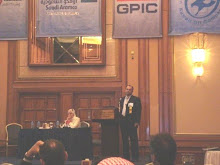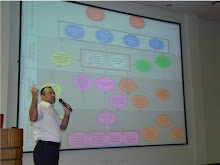Below is a set of recommendations that can help Organizational executives ensure proper alignment between projects pipelined and their organizational strategy. As a bottom-line, projects and strategic development are inter-related as shown below.
Allow Middle Managers Onboard
Most executives are too busy to be involved in structured strategic planning, some got their positions because they are owners, shareholders or simply powerful; they may not have the practical experience needed for strategic planning. Strategic decisions that are based on top-down approach will be partially implemented especially when middle managers don’t feel that they are ‘right’.
Strategic decisions will have better chances of success if they involve managers from all organizational levels and not only executives (Mintzberg, 1994). This will enrich the strategic planning process and improve the feeling of strategic ownership among organizational levels.
I believe that a structured strategic planning framework should not only consider the above mentioned, but also consider roles for strategic planners as catalysts and feedback loops for optimization (March et al., 1976).
Enhance Alignment by Using Projects to Implement Strategy
Once strategy is planned, there should be a method for implementing it. Many studies have addressed the fact that change is a challenge in strategic implementation. However, projects characteristics can integrate both planned strategy and evolving strategy (Mintzberg, 1987). Strategic decisions can be broken down into smaller components and projects can be planned for these components. Senior management will then have measurable criteria to identify the extent of implementation of each strategic decision being made. So, we can see now how they are inter-related!
Understanding the Strategy-Culture-Project link
It is not only structure that counts, it is people that perform. Strategic decisions should consider the organizational culture. If there is a big gap between organizational culture and strategic decisions, these decisions will not survive. And projects planned to implement these strategic decisions will fail.
Strategy can be implemented by projects. To be successful; these projects should be – to a certain extent- aligned with organizational culture. Once completed, these projects themselves cause a small shift in the organizational culture.
In some cases, projects are pipelined mainly to cause incremental cultural change or overcome a cultural barrier that can enable implementing the desired strategy. Many organizations fail to point this link between culture, strategy and projects; and end up with a bigger misalignment.
Effectively Manage Project Portfolios
This is recommended by establishing a Programme/Portfolio Management Office. PMO benefits were thoroughly discussed in another Discussion Topic, although avoiding repetition, I find it important to mention that establishing a balanced scorecard of quantitative criteria for project selection along with rigid decision gates that periodically kill projects that should be killed and hold those waiting for resources are important PMO roles for aligning projects with strategy (Kaplan & Norton, 2000). .
Establish and Enforce Sound organizational Governance
This topic was also addressed in another topic, but I would like to add something here:
Not only should the organization establish a governance structure with clear Roles and Responsibilities, Authorities, Power… but measures should be set to ensure that this governance structure is actually being implemented.
Importance of governance increases at higher levels because that is where most of the influence resides and unfortunately, less monitoring and control. It is not easy to face ‘powerful executives’ with alternative strategies. Those that do so, according to Gordon Donaldson (1995), run the risk of finding themselves isolated, and in time, replaced.
The solution presented in this same article can help resolve the strategic alignment issue on the executive’s level by “strategic Audits”: A formal strategic review process, managed by a committee of independent directors supported with authority.
These strategies, among others, are essential to ensure proper alignment between projects and organization’s strategy. However, I see that the key challenge resides in ‘implementing’ them. Each organization has to integrate its specific conditions, type of business, the pace of strategic change, working environment, and other factors in order to select the right portfolio of practices that suit its needs.
References:
• Donaldson G. (1995), ‘A new Tool for Boards: The Strategic Audit’, Harvard Business Review. pp: 99-107
• Kapalan R.S., Norton D.P. (2000), “Having Trouble With Your Strategy? Then Map it”, Harvard Business Review, September-October 2000, pp.167-176
• March J. and Olsen J. (1976), “Ambiguity and Choice in Organizations”, p.80, Universitetsforlaget, Bergen, Norway.
About The Author

- Eng. Samer el Barakeh, MPM, PMP
- Samer el Barakeh was born in Lebanon, 1973. He completed his Bachelor in Engineering-CCE at Beirut Arab University-Lebanon in 1996 with honours. Samer was granted Masters Degree in Project Management (MPM) from the University of Sydney-Australia with honours. He also gained the Project Management Professional (PMP) Credential from The Project Management Institute (PMI). Samer is a member of the Order of Architects and Engineers in Lebanon since 1996, The Project Management Institute (PMI), Arabian Gulf Chapter (AGC-PMI) and Lebanon Chapter-PMI. During his 13 years of professional experience in Lebanon, Australia and Saudi Arabia, Samer held many positions among them: Telecommunication Site Engineer, Site Manager, Low Current Service Head, and he is currently Senior Systems Analyst at the General Project Construction Division. Samer is a Project Management Consultant and Training Provider for universal organizations like Business Management Consultants (USA) www.bmc-online.com and PMCTQuest (Canada) www.pmctquest.com Samer is a Registered Training Provider for Project Management Professional (PMP), and he provides training in Program Management, Portfolio Management,PMO...
Select a topic to view content
- A comparison between PMBOK and Prince2 Methodologies and reflection on case study examples (1)
- ABC to Avoid Project Failure (1)
- Business Case and Quantitative Benefits (1)
- Do we need more 'Planners' ? (1)
- Fasilitator in Partnering-A Coincise Shot (1)
- How to Ensure Stratgic Alignment of Our Projects? (1)
- Individual Dissimilarity and Team Work (1)
- Knowledge Management (1)
- Maturity Models-The Pros and Cons (1)
- Organizational Advantages from Partnering (1)
- Organizational Maturity: Lets Head Upwards... (1)
- Organizational Strategy and Project Alignement (1)
- Practical Solutions 1 of 6: Introduce RMMM (1)
- Practical Solutions 2 of 6: Facilitate Change to Perk up Maturity (1)
- Practical Solutions 3 of 6: Leverage Organisational Culture Barrier (1)
- Practical Solutions 4 of 6: Organisational Cultural Alignment (1)
- Practical Solutions 5 of 6: Defining a Unified Decision Making Tool (1)
- Practical Solutions 6 of 6: Understanding The Paradox of Control (1)
- Programme Management to Implement Strategy (1)
- Project Management and Construction Management (1)
- Project Managers relocated before Proper Project Closure and Learning Lessons (1)
- Project Managers' Power (1)
- Strategic Planning (1)
- Successful Project Management Office-PMO (1)
- System Thinking: Archetypes at Work... (1)
- The Partnering Change Process (1)
- The Upper Hand… Leadership skills or Processes? (1)
- Thinking about change needed? Maybe you should be more ‘worried’ about how to make it real (1)
- Vision Mission and Objectives What and Why? (1)
- What is meant by Portfolio and Programme Management (1)
- Why Partnering in Organizations? (1)
June 22, 2008
How to Ensure Stratgic Alignment of Our Projects?
Posted by
Eng. Samer el Barakeh, MPM, PMP
at
1:24 AM
![]()
![]()
Subscribe to:
Post Comments (Atom)
Followers
All Titles
A comparison between PMBOK and Prince2 Methodologies and reflection on case study examples
ABC to Avoid Project Failure
Business Case and Quantitative Benefits
Do we need more 'Planners' ?
Fasilitator in Partnering-A Coincise Shot
How to Ensure Stratgic Alignment of Our Projects?
Individual Dissimilarity and Team Work
Knowledge Management
Maturity Models-The Pros and Cons
Organizational Advantages from Partnering
Organizational Maturity: Lets Head Upwards...
Organizational Strategy and Project Alignement
Practical Solutions 1 of 6: Introduce RMMM
Practical Solutions 2 of 6: Facilitate Change to Perk up Maturity
Practical Solutions 3 of 6: Leverage Organisational Culture Barrier
Practical Solutions 4 of 6: Organisational Cultural Alignment
Practical Solutions 5 of 6: Defining a Unified Decision Making Tool
Practical Solutions 6 of 6: Understanding The Paradox of Control
Programme Management to Implement Strategy
Project Management and Construction Management
Project Managers relocated before Proper Project Closure and Learning Lessons
Project Managers' Power
Strategic Planning
Successful Project Management Office-PMO
System Thinking: Archetypes at Work...
The Partnering Change Process
The Upper Hand… Leadership skills or Processes?
Thinking about change needed? Maybe you should be more ‘worried’ about how to make it real
Vision Mission and Objectives What and Why?
What is meant by Portfolio and Programme Management
Why Partnering in Organizations?

















Executives and managers of organizations both large and small manage portfolios of assets and activities representing what the business is and what it does. Managed well, these portfolios directly support the effective and efficient achievement of mission goals. Managed poorly, these portfolios target achievement of differing and sometimes competing objectives or inappropriately expend resources on low value activities; ultimately diminishing the organization’s ability to maximize value creation. Thus, the focus of portfolio management is the optimization of resource deployment across the collection of activities most directly supporting achievement of mission goals.
ReplyDeleteTypes of Portfolios
Portfolios are the collections of either assets sharing similar characteristics or activities supporting achievement of common objectives. Individual items with the collection may or may not be interdependent or directly related. These logical groupings, however, facilitate measurement, comparison, and prioritization which in-turn provides portfolio managers with the information necessary to make and implement decisions that maximize value creation for the resources expended.
Management of asset and activity portfolios requires a different focus and skill set. While both asset and activity portfolio management involve the management of resources, asset portfolio management focuses on value creation through the acquisition, deployment, and release of resources whereas activity portfolio management focuses on the prioritization, selection, and execution of value creating work using resources. To better illustrate this concept, the following asset and activity portfolio definitions are offered:
* Asset Portfolios: collections of items the use of which generate value
* Financial: collections of convertible instruments that create value and/or can be exchanged for other resources. Examples include: cash reserves, options, stocks, and bonds
* Material: collections of physical property used in the creation of value adding products and services. Examples include: structures, equipment and tools, and raw materials, components, and supplies
* Intellectual: collections of knowledge resources used in the creation of value adding products and services. Examples include: data, patents, copyrights, trademarks, and retained human knowledge and experience
* Labor: collections of employees, typically grouped by skill set, who perform value adding work. Examples include: managers, engineers, graphic designers, and mechanics
* Activity Portfolios: collections of business activities through which value is created or enhanced.
* Operational Portfolios: collections of the major, ongoing and repetitive activities that either directly or indirectly support organizational value generation. Examples include: marketing, sales, production (of goods and/or services), maintenance, human resources, and finance
* Project Portfolios: collections of projects typically used to enhance or expand existing operational portfolio activities. Examples include: business process reengineering, enterprise resource planning software implementation, and new product/service development
Note: While effective management of both asset and activity portfolios is critical to the success of any organization, postings within the Portfolio Management category will focus on activity portfolios. Insights regarding the management of asset portfolios will be provided within the Resource Management category.
Activity Alignment with Mission Goals
Aligning activity portfolios with the organization’s mission goals necessarily begins with the strategic planning process. Because no one project or recurring activity is likely to satisfy all of an organization’s goals, executives and managers work together to identify, prioritize, and select collections of activities possessing the greatest value potential for a given cost, bounded by the organization’s limited resource availability. Quantifiable measures of value and cost assigned to aid in activity prioritization and selection are then translated into performance measures against which the portfolio manager judges the collection’s ongoing mission alignment.
Effective, Efficient Deployment of Resources
Today’s rapidly changing business environment and the dynamic nature of operational activity and project execution demands continuous reevaluation, reprioritization, and, as necessary, redistribution of the organization’s limited resources away from low and no value adding work to those more directly supporting goal achievement. Making resource allocation adjustments to maximize an activity portfolio’s value is, subsequently, a primary responsibility of the portfolio manager.
In order to maximize a portfolio’s ongoing value creation, portfolio managers must act to ensure performance of their portfolio’s activities remains in alignment with and drives achievement of stated mission goals. Therefore, these managers need to clearly understand the organization’s overall objective goals and the value proposition of each activity within their portfolios. It is with this knowledge that they divert resources from low and no value adding work to those more directly supporting goal achievement.
Focus of StrategyDriven's Portfolio Management Category
Posts within StrategyDriven's Portfolio Management Category focus on the underlying principles, best practices, and warning flags associated with maintaining effective activity portfolio alignment with mission goals while, at the same time, efficiently deploying the organization’s limited resources. We hope you'll consider visiting the StrategyDriven website today and becoming an active member of our community.
All the Best,
Nathan Ives
Principal Contributor and
co-Host, StrategyDriven Podcast
StrategyDriven
www.StrategyDriven.com
This comment has been removed by a blog administrator.
ReplyDelete